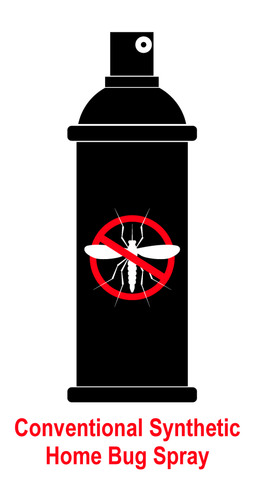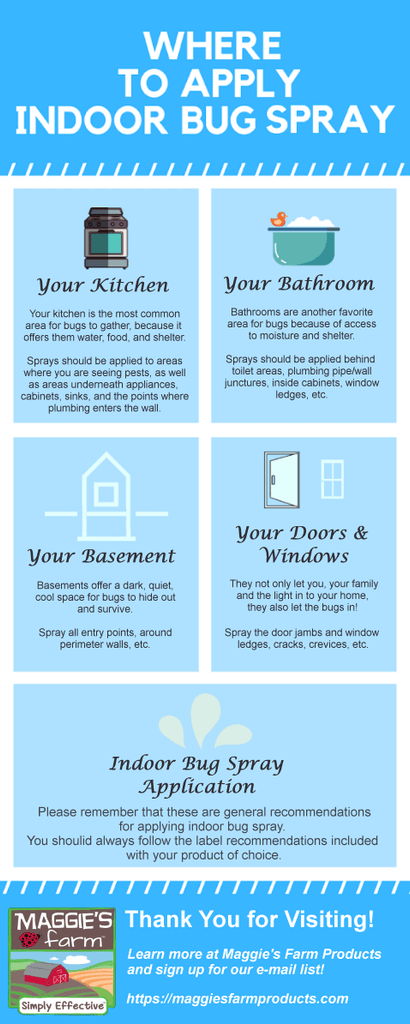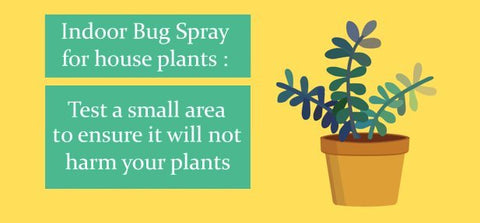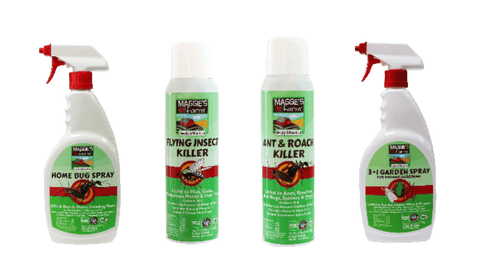When you find your home overrun with bugs, you need a quick solution. Knowing what indoor bug spray will provide you with an effective solution is important. Before deciding which spray to use, there are things to consider. Some sprays are ready-to-use while others are a concentrate that requires mixing. There are products formulated with synthetic chemicals and some are considered green. Having so many options can be confusing, which is why we’re breaking down the options. We’ve gathered information about indoor bug sprays to help you find your best solution.
What are Some of the Most Common Indoor Bugs?
Many pests try to make themselves at home in your house. Some are an annoyance, others are harmful to plants, and some can be harmful to you and your family.
Check out the pests you are most likely to encounter at home:
- Ants
- Bed Bugs
- Beetles
- Boxelder Bugs
- Crickets
- Cockroaches
- Drain Flies
- Earwigs
- Firebrats
- Fleas
- Flies
- Fruit Flies
- Gnats
- Silverfish
- Spiders
- Stinkbugs
- Ticks
- Wasps
How to Prevent Indoor Bugs
The best remedy for a pest infestation is to do whatever you can to avoid having one to begin with. Pest control products can be helpful in controlling bugs in and around our homes, but they should never be your one and only strategy. Many species of insects develop resistance over time to many of the synthetic pest control products commonly used.
Integrated Pest Management (IPM) is a comprehensive, holistic, more earth-friendly approach to pest control that relies on physical/environmental, biological, and mechanical control methods first, before resorting to the use of pest control products. It takes into account “acceptable” levels of pest populations and using earth-friendly pest control methods (attracting natural predators like birds, bats, and predatory insects, and nurturing plants that act as natural pest repellents, etc.) to maintain a healthy ecological balance in an environment.
How can you implement IPM methods more into your pest management approach? Following are some suggestions.

Seal/block off places where pests can enter your home and/or hide.
- Assess how well doors and windows are sealed up. Replace door and window weather stripping as needed. This will also help reduce your utility bills. Make sure all your screens are in good repair.
-
Caulk cracks, crevices, and utility entry points (indoors and out), and around cabinets or baseboards. Use steel wool to fill spaces around pipes and cables. Fix holes or cover them with wire mesh.
Eliminate sources of water, food, and shelter. Make house pests feel unwelcome! This will include keeping your home and yard tidy, clean, and well-kept. Bugs love liquid spills, leaks, food crumbs, cracks in walls and corners, and clutter. Since prevention is always the best remedy, make sure you give bugs no excuse to come live in your home.
- Learn about the pests you have, might have, and about the options you have to control them.
- Check for pests in backpacks, luggage, bags, packages, and boxes before carrying them into your home.
- Fix leaky plumbing and don't let water accumulate anywhere. Careful that water doesn’t collect in trays underneath plants or your refrigerator. Don't leave pet water (or food) out overnight.
- Keep food (including pet food) in sealed containers: plastic, or preferably glass.
- Garbage with food scraps should be kept in tightly-covered trash cans. Take trash out regularly.
- Eliminate clutter. Get rid of empty boxes, stacked newspapers and magazines, etc.
- Keep lawn and foliage trimmed, remove or refresh any stagnant water from your yard (i.e. pet dishes, kiddie pools, birdbaths, puddled water, etc.). Keep foliage/branches trimmed at least 12–24 inches from the side of your house to reduce bug entry-points.

How to Choose the Best Indoor Bug Spray
There are two main types of active ingredients used to formulate indoor bug killers: synthetic (formulated in a lab) or naturally derived/naturally occurring formulations (a.k.a. green, botanical, earth-friendly, etc.), which take a greener approach to pest control by using plant-based ingredients or essential oils as their active ingredients.
Though there are many terms used to describe “green” pest control products, they should not necessarily be used interchangeably. Read more about the differences between natural, organic, and green products.
Indoor bug sprays can be divided into two main categories: aerosol and non-aerosol sprays. Aerosols, once deemed harmful to our earth’s ozone layer, now virtually all use different propellants for delivery that are much more environmentally safe to use (at least the ones allowed for sale in the United States). Non-aerosol sprays are applied using some sort of trigger-action applicator.
The most effective bug spray for the house will not only kill bugs on contact, they should also provide some residual protection.

Synthetic Bug Sprays
The most common ingredients used to formulate conventional bug sprays are synthetic chemicals. These synthetics are widely used by PMPs, as well as for pest management for commercial crops. These synthetic formulations are effective against a wide range of insects.
They are labeled for home pest control, though many of these synthetic chemicals take longer to break down in soil. These chemicals can be highly toxic to fish and other animals. They can also cause allergic reactions in people with certain skin types, and they should never be used around pregnant women.
Green Bug Sprays
People aren’t the only ones who want to get rid of bugs! Did you know that plants use their own oils as a built-in defense system against pests? Plants want protection from them, too!
If you prefer to choose a more earth-friendly bug spray for the house, you can still count on a high bug kill rate. Most green bug sprays are formulated using some combination of plant-based ingredients and/or essential oils (e.g., peppermint oil, wintergreen oil, geraniol, cedar extract, citronella, rosemary oil, etc.). Naturally derived sprays are healthier for the environment and your family since they break down more quickly in the environment, do not leave behind any harmful residues, and are more kid- and pet-friendly.
Indoor bug sprays may be for a general type of pest (e.g., for flying insects), or may be more targeted (e.g., for ants and cockroaches).

Advantages to Choosing a Plant-Based Insecticide Spray
When picking an indoor pest control spray, you’ll want to find one that’s not only effective but also best for your family. Check out a few reasons why plant-based insecticide sprays are a great option.
- Quick Kill: The correct combination of essential oils can kill pests quickly when they are sprayed directly.
- Residual Repellency: After spraying, the plant essential oil vapors will create a protective barrier that helps to keep pests away.
- Family-Friendly: Plant-based insecticide sprays are potent to bugs. However, they have a much lower toxicity for humans and pets. When used as directed, they are a more family-friendly solution.
- Environmentally Friendly: These sprays don’t leave behind harmful residues and won’t persist in the environment. This means they can be used not only in your home but also outside.
- Beneficial Insects: Plant-based insecticide sprays are a better option for beneficial insects. While insects are killed on contact, bugs not sprayed directly will only be repelled.
- Natural Fragrance: Plants are known to have pleasant fragrances, and so do essential oils. Plant-based insecticides have a more natural fragrance rather than an artificial one.
Where Do You Apply an Indoor Bug Spray?
You want to focus your applications mostly for areas where food and moisture will readily be available to the pest. You can find pests in any room of your house, but for most homes, the kitchen, bathroom, and laundry room are prime areas for them to hang out. Also, the garage, crawlspaces, basement, and attic, as these places are quiet, out of the way, and provide great places to hide.
Be sure to treat behind baseboards, underneath and inside sink cabinets, and around plumbing entry points. A light, targeted spray is usually all you need to leave a pest barrier that keeps working for weeks.
Pests also frequently occupy basements because of the high levels of humidity and moisture found underground. They are dark, quiet, and offer great places to hide.


Bug Spray for Plants
If you are looking for an indoor bug spray for plants, you will need a product labeled to treat plants. Be careful as indoor plants are not as hearty as outdoor plants, and those botanical oils can burn your indoor foliage if not used properly. We would recommend testing on a small section of a leaf to make sure the spray does not harm your plants.
When you are trying to control small flies or gnats that are breeding in the organic matter of your plants you can use an indoor fly spray to control the adults that are driving you crazy. Usually, the best control method is to allow the potting soil and trays to dry out completely. Ensure you have adequate drainage to prevent fungus gnats from re-spawning.

When is the Best Time of Year to Spray for Bugs?
Anytime you see bugs, you can spray for them. You can also spray before they become a problem with a preventative outdoor spray. It’s best to do this in early spring right before bug season starts. You’ll catch bugs when they first become active before they can reproduce and find a new home.
Spraying in the fall can help prevent overwintering pests like boxelder bugs and Asian lady beetles. These pests sneak into homes to escape the cold weather. They gravitate to undisturbed locations like attics and crawl spaces.
When to Call a Professional
Sometimes bug problems are too much to handle on your own. Here are a few reasons you should call a professional pest control company.
- You’re Outnumbered: Large infestations of pests happen. Some pests, like German cockroaches, millipedes, and stink bugs, can invade in large numbers under the right conditions. These situations can be too much to handle. Thorough treatment is necessary and often requires treating attics, crawl spaces, eaves, and soffits. A professional has the equipment and experience to treat for pests on a large scale.
- Pests That Cause Structural Damage: Carpenter ants and termites can cause serious damage to your home. If you find signs of these pests, you should consider contacting a professional.
- Bed Bugs: Some bed bug infestations can be handled at home with the right treatment plan. However, these pests can be difficult to control since they reproduce and spread quickly. A pest management professional can help eliminate an infestation.

No one wants to deal with bugs in their home. When they do invade, you need an effective solution. Knowing your options can help make the decision easier and ease the headache that pests can bring. If you’re dealing with a pest problem, we’re here to help! Check out our Maggie’s Farm Simply Effective™ Pest Control products.

For scientifically-tested, effective pest control that is better for the environment, try Maggie’s Farm pest control products. Our promise is that our plant and mineral-based products are developed by scientists and seasoned pest control professionals to be the most effective family of green pest control products on the market. Find out why life’s better on the farm!
